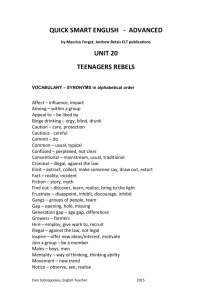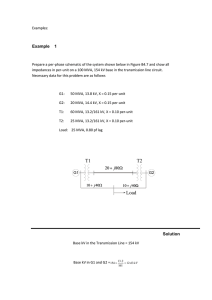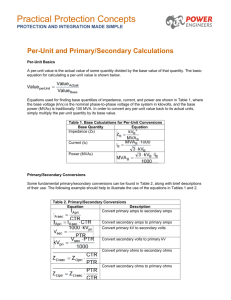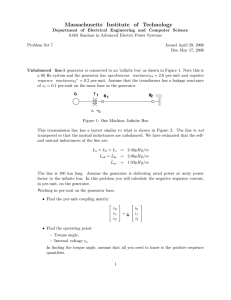Lecture 10 - Lamar University`s electrical engineering
advertisement
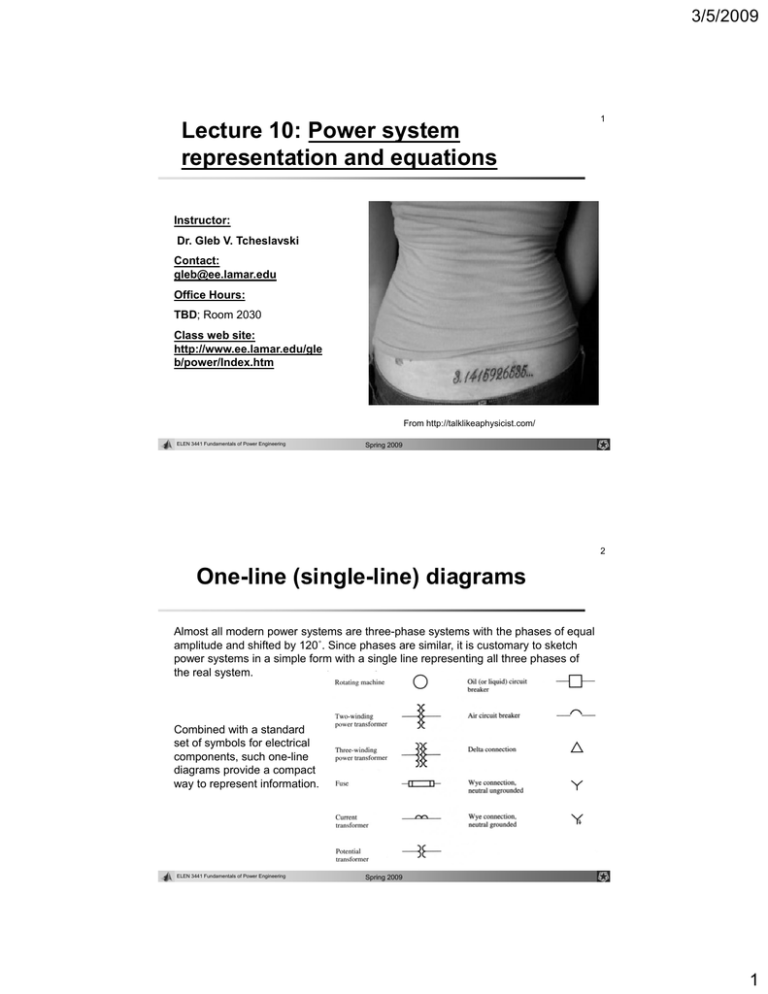
3/5/2009 Lecture 10: Power system representation and equations 1 Instructor: Dr. Gleb V. Tcheslavski Contact: gleb@ee.lamar.edu Office Hours: TBD; Room 2030 Class web site: http://www.ee.lamar.edu/gle b/power/Index.htm From http://talklikeaphysicist.com/ ELEN 3441 Fundamentals of Power Engineering Spring 2009 2 One-line (single-line) diagrams Almost all modern power systems are three-phase systems with the phases of equal amplitude and shifted by 120˚. Since phases are similar, it is customary to sketch power systems t in i a simple i l fform with ith a single i l liline representing ti allll three th phases h off the real system. Combined with a standard set of symbols for electrical components, such one-line diagrams provide a compact way to represent information. ELEN 3441 Fundamentals of Power Engineering Spring 2009 1 3/5/2009 3 One-line (single-line) diagrams Example 10.1: a power system containing two synchronous machines, two loads, two busses, two transformers, and a transmission line to connect busses together. All devices are protected by oil circuit breakers (OCBs). We notice that the diagram indicates the type of connection for each machine and transformer, and also the points in the system connected to the ground. The ground connections are important since they affect the current flowing in nonsymmetrical faults. These connection can be direct or through a resistor or inductor (they help reducing the fault current that flows in unsymmetrical faults, while having no impact on the steady-state operation of the system since the current through them will be zero). Machine ratings, impedances, and/or consumed (or supplied) powers are usually included in the diagrams. ELEN 3441 Fundamentals of Power Engineering Spring 2009 4 Per-phase, per-unit equivalent circuits As we have learned, the easiest way to analyze a balanced three-phase circuit is by a per-phase equivalent circuit with all Δ connections converted in their equivalent Y connections. The solution obtained can be extended to three p phases knowing g that the voltages and currents in other two phases would be the same except for the 120˚ phase shift. An advantage of per-unit representation is that circuits containing transformers can be easily analyzed. Real power systems are convenient to analyze using their per-phase (since the system is three-phase) per-unit (since there are many transformers) equivalent circuits. The per-phase base voltage, current, apparent power, and impedance are I base = Z base = ELEN 3441 Fundamentals of Power Engineering S1φ ,base VLN ,base I base (10.4.1) VLN ,base (V = LN ,base ) 2 (10.4.2) S1φ ,base Spring 2009 2 3/5/2009 5 Per-phase, per-unit equivalent circuits Where VLN,base is the line-to-neutral base voltage in the three-phase circuit (same as the base phase voltage in a Y-connected circuit) S1φ,base is the base apparent power of a single g p phase in the circuit. The base current and impedance in a per-unit system can also be expressed in terms of the three-phase apparent power (which is 3 times the apparent power of a single phase) and line-to-line voltages (which is 3 times the line-to-neutral voltage): I base = Z base = VLL ,base 3I base S3φ ,base (10.5.1) 3VLL ,base (V = LL ,base ) 2 (10.5.2) S3φ ,base In the per-unit system, all quantities are represented as a fraction of the base value: Quantity in per − unit = ELEN 3441 Fundamentals of Power Engineering actual value base value of quantity (10.5.3) Spring 2009 6 Per-phase, per-unit equivalent circuits If any two of the four base quantities are specified, the other base values can be calculated. Usually, base apparent power and base voltage are specified at a point in the circuit,, and the other values are calculated from them. The base voltage g varies by the voltage ratio of each transformer in the circuit but the base apparent power stays the same through the circuit. The per-unit impedance may be transformed from one base to another as: 2 ⎛V ⎞ ⎛S ⎞ Per − unit Z new = per − unit Z old ⎜ old ⎟ ⎜ new ⎟ ⎝ Vnew ⎠ ⎝ Sold ⎠ (10.6.1) Example 10.2: a power system consists of one synchronous generator and one synchronous motor connected by two transformers and a transmission line line. Create a per-phase, per-unit equivalent circuit of this power system using a base apparent power of 100 MVA and a base line voltage of the generator G1 of 13.8 kV. Given that: G1 ratings: 100 MVA, 13.8 kV, R = 0.1 pu, Xs = 0.9 pu; T1 ratings: 100 MVA, 13.8/110 kV, R = 0.01 pu, Xs = 0.05 pu; T2 ratings: 50 MVA, 120/14.4 kV, R = 0.01 pu, Xs = 0.05 pu; M ratings: 50 MVA, 13.8 kV, R = 0.1 pu, Xs = 1.1 pu; L1 impedance: R = 15 Ω, X = 75 Ω. ELEN 3441 Fundamentals of Power Engineering Spring 2009 3 3/5/2009 7 Per-phase, per-unit equivalent circuits To create a per-phase, per-unit equivalent circuit, we need first to calculate the impedances of each component in the power system in per-unit to the system base The system base apparent power is Sbase base. = 100 MVA everywhere in the b power system. The base voltage in Vbase ,1 = 13.8 kV Region 1 the three regions will vary as the voltage ratios of the transformers 110 Vbase ,2 = Vbase ,1 = 110 kV Region 2 that delineate the regions. These 13.8 base voltages are: Vbase ,3 = Vbase,2 ELEN 3441 Fundamentals of Power Engineering 14.4 = 13.2 kV 120 (10.7.1) Region 2 Spring 2009 8 Per-phase, per-unit equivalent circuits The corresponding base impedances in each region are: Z base b ,1 1 = Z base ,2 = Z base ,3 = VLL ,base 2 S3φ ,base VLL ,base 2 S3φ ,base VLL ,base 2 S3φ ,base = = = (13.8 kV ) 2 100 MVA (110 kV ) = 1.904 Ω Region 1 = 121 Ω Region 1 = 1.743 Ω Region 1 2 100 MVA (13.2 kV ) (10.8.1) 2 100 MVA The impedances of G1 and T1 are specified in per-unit per unit on a base of 13 13.8 8 kV and 100 MVA, which is the same as the system base in Region 1. Therefore, the per-unit resistances and reactances of these components on the system base are unchanged: RG1,pu = 0.1 per unit XG1,pu = 0.9 per unit RT1,pu = 0.01 per unit XT1,pu = 0.05 per unit ELEN 3441 Fundamentals of Power Engineering Spring 2009 4 3/5/2009 9 Per-phase, per-unit equivalent circuits There is a transmission line in Region 2 of the power system. The impedance of the line is specified in ohms, and the base impedance in that region is 121 Ω. Therefore, the p per-unit resistance and reactance of the transmission line are: 15 = 0.124 per unit 121 75 = = 0.620 per unit 121 Rline, system = X line , system (10.9.1) The impedance of T2 is specified in per-unit on a base of 14.4 kV and 50 MVA in Region 3. Therefore, the per-unit resistances and reactances of this component on the system base are: per − unit Z new = per − unit Z given (Vgiven Vnew ) ( S new S given ) 2 RT 2, pu = 0.01(14.4 13.2 ) (100 50 ) = 0.238 per unit (10.9.2) 2 X T 2, pu = 0.05 (14.4 13.2 ) (100 50 ) = 0.119 per unit 2 ELEN 3441 Fundamentals of Power Engineering (10.9.3) Spring 2009 10 Per-phase, per-unit equivalent circuits The impedance of M2 is specified in per-unit on a base of 13.8 kV and 50 MVA in Region 3. Therefore, the per-unit resistances and reactances of this component on the system y base are: per − unit Z new = per − unit Z given (Vgiven Vnew ) ( S new S given ) 2 RM 2, pu = 0.1(14.8 13.2 ) (100 50 ) = 0.219 per unit 2 X M 2, pu = 1.1(14.8 13.2 ) (100 50 ) = 2.405 per unit 2 (10.10.1) Therefore, the perphase, per-unit equivalent circuit of this power system is shown: ELEN 3441 Fundamentals of Power Engineering Spring 2009 5 3/5/2009 11 Writing node equations for equivalent circuits Once the per-phase, per-unit equivalent circuit of a power system is created, it can be used to find the voltages, currents, and powers present at various points in a power system. p y The most common technique q used to solve such circuits is nodal analysis. In nodal analysis, we use Kirchhoff’s current law equations to determine the voltages at each node (each bus) in the power system, and then use the resulting voltages to calculate the currents and power flows at various points in the system. A simple three-phase power system with three b busses connected t db by th three ttransmission i i lilines. The system also includes a generator connected to bus 1, a load connected to bus 2, and a motor connected to bus 3. ELEN 3441 Fundamentals of Power Engineering Spring 2009 Writing node equations for equivalent circuits 12 The per-phase, per-unit equivalent circuit of this power system: The busses are labeled as nodes (1), (2), and (3), while the neutral is labeled as node (n). Note that the per-unit series impedances of the transformers and the transmission lines between each pair of busses have been added up, and the resulting impedances were expressed as admittances (Y=1/Z) to simplify nodal analysis. Shunt admittance at each bus is shown between the bus and the neutral. This admittance can include the shunt admittance of the line models and shunt admittance associated with any generators or loads on a bus. ELEN 3441 Fundamentals of Power Engineering Spring 2009 6 3/5/2009 13 Writing node equations for equivalent circuits The voltages between each bus and neutral are represented by single subscripts (V1, V2) in the equivalent circuit, while the voltages between any two busses are indicated byy double subscripts p ((V12)). The generators and loads are represented by current sources injecting currents into the specific nodes. Conventionally, current sources always flow into a node meaning that the power flow of generators will be positive, while the power flow for motors will be negative. According to Kirchhoff’s current flow law (KCL), the sum of all currents entering any node equals to the sum of all currents leaving the node. KCL can be used to establish and solve a system of simultaneous equations with the unknown node voltages voltages. Assuming that the current from the current sources are entering each node, and that all other currents are leaving the node, applying the KCL to the node (1) yields: (V1 − V2 ) Ya + (V1 − V3 ) Yb + V1Yd = I1 ELEN 3441 Fundamentals of Power Engineering (10.13.1) Spring 2009 Writing node equations for equivalent circuits 14 Similarly, for the nodes (2) and (3): (V2 − V1 ) Ya + (V2 − V3 ) Yc + V2Ye = I 2 (V3 − V1 ) Yb + (V3 − V2 ) Yc + V3Y f = I3 (10.14.1) (10.14.2) Rearranging these equations, we arrive at: (Ya + Yb + Yd )V1 − YaV2 − YbV3 = I1 −YaV1 + (Ya + Yc + Ye ) V2 − YcV3 = I 2 (10.14.3) −YbV1 − YcV2 + (Yb + Yc + Y f ) V3 = I 3 In matrix form: ⎡Ya + Yb + Yd ⎢ −Ya ⎢ ⎢ −Yb ⎣ ELEN 3441 Fundamentals of Power Engineering ⎤ ⎡V1 ⎤ ⎡ I1 ⎤ −Ya −Yb ⎥⎢ ⎥ ⎢ ⎥ −Yc Ya + Yc + Ye ⎥ ⎢V2 ⎥ = ⎢ I 2 ⎥ −Yc Yb + Yc + Y f ⎥⎦ ⎢⎣V3 ⎥⎦ ⎢⎣ I 3 ⎥⎦ (10.14.4) Spring 2009 7 3/5/2009 15 Writing node equations for equivalent circuits Which is an equation of the form: Ybus b V = I ((10.15.1)) where Ybus is the bus admittance matrix of a system, which has the form: Ybus ⎡Y11 Y12 Y13 ⎤ = ⎢⎢Y21 Y22 Y23 ⎥⎥ ⎢⎣Y31 Y32 Y33 ⎥⎦ (10.15.2) Ybus b has a regular form that is easy to calculate: 1) The diagonal elements Yii equal the sum of all admittances connected to node i. 2) Other elements Yij equal to the negative admittances connected to nodes I and j. The diagonal elements of Ybus are called the self-admittance or driving-point admittances of the nodes; the off-diagonal elements are called the mutual admittances or transfer admittances of the nodes. ELEN 3441 Fundamentals of Power Engineering Spring 2009 16 Writing node equations for equivalent circuits Inverting the bus admittance matrix Ybus yields the bus impedance matrix: −1 Z bus b = Ybbus ((10.16.1)) Simple technique for constructing Ybus is only applicable for components that are not mutually coupled. The technique applicable to mutually coupled components can be found elsewhere. Once Ybus is calculated, the solution to (10.15.1) is or ELEN 3441 Fundamentals of Power Engineering −1 V = Ybus I (10.16.2) V = Ζbus I (10.16.3) Spring 2009 8 3/5/2009 17 Solving power system node equation with MATLAB™ A number of techniques can be used to solve systems of simultaneous linear equations, such as substitution, Gaussian elimination, LU factorization, etc. MATLAB y solvers that can be used efficiently. y has build-in system A system of n linear equations in n unknowns Ax = b (10.17.1) where A is an n x n matrix and b is and n-element column vector; the solution will be x = A−1b (10.17.2) where A-1 is the n x n matrix inverse of A. Using MATLAB, the solution to (10.17.1) can be evaluated, for instance, by direct evaluation of inverse as in (10.17.2), or via the left division (\). ELEN 3441 Fundamentals of Power Engineering Spring 2009 Solving power system node equation with MATLAB™ 18 For example, the system 1.0 x1 + 0.5 x2 − 0.5 x3 = 1.0 0.5 x1 + 1.0 x2 + 0.25 x3 = 2.0 −0.5 x1 + 0.25 x2 + 1.0 x3 = 1.0 Can be solved by the following MATLAB code: >> A = [1, 0.5, -0.5; 0.5, 1, 0.25; -0.5, 0.25, 1]; >> b = [1; 2; 1]; >> x = inv(A) * b; or >> x = A\b; ELEN 3441 Fundamentals of Power Engineering Spring 2009 9 3/5/2009 Solving power system node equation with MATLAB™ 19 Example 10.3: a power system consists of four busses interconnected by five transmission lines. It includes one generator attached to bus 1 and one synchronous motor connected to bus 3. ELEN 3441 Fundamentals of Power Engineering Spring 2009 Solving power system node equation with MATLAB™ 20 The per-phase, per-unit equivalent circuit is shown. We observe that all impedances are considered as pure reactances to simplify the case since reactance is much larger than resistance in typical transformers, synchronous machines, and overhead transmission lines. Find the per-unit voltage at each bus in the power system and the per-unit current flow in line 1. ELEN 3441 Fundamentals of Power Engineering Spring 2009 10 3/5/2009 Solving power system node equation with MATLAB™ 21 The first step in solving for bus voltages is to convert the voltage sources into the equivalent current sources by using the Norton’s theorem. Next, we need to convert p values into admittances and form the admittance matrix Ybus all of the impedance then use it to solve for the bus voltages, and finally use voltages on buses 1 and 2 to find the current in line 1. First, we need to find the Norton equivalent circuits for the combination of G1 and T1. The Thevenin impedance of this combination is ZTH = j1.1, and the short-circuit current is I sc = Voc 1.1∠10° = = 1.0∠ − 80° ZTH j1.1 11 (10.21.1) The Norton’s equivalent circuit. ELEN 3441 Fundamentals of Power Engineering Spring 2009 Solving power system node equation with MATLAB™ 22 The combination of M3 and T2 is shown. The Thevelin impedance of this combination is ZTH = j1.6, and the short-circuit th h t i it currentt is i I sc = Voc 0.9∠ − 22° = = 0.563∠ − 112° ZTH j1.6 (10.22.1) The Norton’s equivalent circuit. ELEN 3441 Fundamentals of Power Engineering Spring 2009 11 3/5/2009 23 Solving power system node equation with MATLAB™ The per-phase, per-unit circuit with the current sources included The same circuit with impedances converted to admittances ELEN 3441 Fundamentals of Power Engineering Spring 2009 Solving power system node equation with MATLAB™ 24 The resulting admittance matrix is: Ybus j 5.0 0 j 6.667 ⎤ ⎡ − j12.576 ⎢ j 5.0 − j12.5 j 5.0 j 2.5 ⎥⎥ =⎢ ⎢ 0 j 5.0 −10.625 j 5.0 ⎥ ⎢ ⎥ j 2.5 j 5.0 − j14.167 ⎦ ⎣ j 6.667 (10.24.1) The current vector for this circuit is: ⎡ 1.0∠ − 80° ⎤ ⎢ ⎥ 0 ⎥ I =⎢ ⎢0.563∠ − 112°⎥ ⎢ ⎥ 0 ⎣ ⎦ ELEN 3441 Fundamentals of Power Engineering (10.24.2) Spring 2009 12 3/5/2009 Solving power system node equation with MATLAB™ 25 The solution to the system of equations will be 0 989∠ − 00.60 60° ⎤ ⎡ 0.989 ⎢ 0.981∠ − 1.58° ⎥ −1 ⎥V V = Ybus I =⎢ ⎢ 0.974∠ − 2.62°⎥ ⎢ ⎥ ⎣ 0.982∠ − 1.48° ⎦ (10.25.1) The current in line 1 can be calculated from the equation: I1 = (V1 − V2 ) Yline1 = ( 0.989∠ − 0.60° − 0.981∠ − 1.58° ) ⋅ ( − j5.0 ) = 0.092∠ − 25.16° ELEN 3441 Fundamentals of Power Engineering (10.25.2) Spring 2009 13
